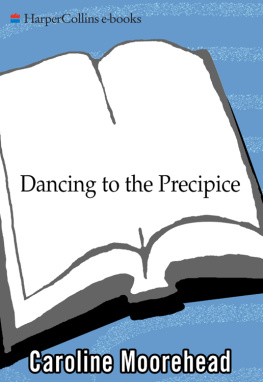Lucies family and friends
Arthur, Comte Dillon (175094) ( father ). Colonel-proprietor of the Dillon regiment serving under Louis XVI. At 18 married his cousin Thrse-Lucy de Rothe, and after her death Comtesse de la Touche, first cousin of the Empress Josephine. Arthur fought in the American Revolution, was promoted General and made governor of Tobago. He returned to Paris to represent Martinique at the Estates General, then fought on the side of the republican army. Having tried to save the Kings life, he was himself arrested and guillotined on 13 April 1794.
Lucy de Rothe (?1804) ( grandmother ). After the death of her only daughter, Lucies mother, Mme de Rothe brought up her granddaughter with great severity. Assumed to be the mistress of her uncle, Archbishop Dillon, she presided over his household until the revolution, when they fled to Germany, and then to England.
Thrse-Lucy de Rothe (175182) ( mother ). Married at 17 to her cousin Arthur whom she thought of as a brother, she had two children: Georges, who died before his second birthday, and Lucie. She became lady-in-waiting to Marie Antoinette, but died of tuberculosis at the age of 31.
Richard-Arthur Dillon, Archbishop of Narbonne (17211806) ( great-uncle ). A worldly administrator rather than a pious prelate, the Archbishop kept a famed hunt at Hautefontaine north of Paris. Lucie accompanied him on several occasions to his see, Montpellier, where he lived in great splendour. Forced to flee France after the attack on the clergy, he spent his last years in exile in London. He was the life-long companion and lover of Lucies grandmother, Mme de Rothe.
Frdric-Sraphim, Comte de Gouvernet and later Marquis de la Tour du Pin Gouvernet (17591837) ( husband ). A soldier by profession, Frdric served with Lafayette in the American Revolution. Briefly a diplomat, he was forced into hiding by the revolution and fled with Lucie to America. Later he was chosen by Napoleon as Prefect of Brussels and then Amiens. He represented France at the Congress of Vienna and was appointed Ambassador to Turin.
Jean-Frdric de la Tour du Pin Gouvernet (17271794) ( father-in-law ). A prominent soldier and Minister for War under Louis XVI, he was arrested during the Terror and sent to the guillotine.
Adelade-Flicit-Henriette dHnin (17501820?) ( Frdrics aunt ). Married at 15 to the Prince dHnin, from whom she lived separated, she became the centre of a group of clever, influential women in Paris. By nature irascible and impetuous, but also generous and devoted, she played an important part in Lucies life. The Princesse dHnin was lady-in-waiting to Marie Antoinette and spent much of her lifeafter her husband went to the guillotineas companion to Trophime-Grard, Marquis de Lally-Tollendal, deputy to the Estates General in 1789 and later member of the Acadmie Franaise.
Flicie de Duras, Comtesse de la Rochejacquelein (17981883) ( goddaughter ). Daughter of Lucies friend Claire de Duras, Flicie became Lucies main correspondent for the last 30 years of her life. Boyish and impetuous, she embroiled Lucies son, Aymar, in a disastrous escapade.
Lady Jerningham (17481825) ( aunt ). When Lucie and Frdric fled to London in 1798, they found a home with Lady Jerningham and her family at Cossey Hall in Norfolk. Lucie was very attached to her English aunt.
Fanny Dillon (17851836) ( half-sister ). The only surviving daughter of Arthur and his second wife, Fanny married General Bertrand, faithful follower of Napoleon, and had four childen. They accompanied the deposed Emperor to St Helena.
Lucies six children:
Humbert (17901816) Sous-Prfet under Napoleon and lieutenant in the Black Musketeers; Humbert was killed in a duel.
Sraphine (17935).
Alix , known as Charlotte (17961822) who died of tuberculosis.
Edward (1798) who died aged a few months.
Ccile (180017) who died of tuberculosis soon after her 17th birthday.
Aymar (180667) who was the only one of her children to survive her.
Lucie had two grandchildren to whom she was close:
Ccile (181893), daughter of Charlotte and brought up by Lucie.
Hadelin (181690), son of Charlotte who rose to prominence in the political and social world of Brussels.
Characters in France
Angoulme, Marie-Thrse d , (17781851). The only surviving daughter of Louis XVI, she accompanied her uncle, later Louis XVIII, into exile in England and married her cousin, the Duc dAngoulme. During the Bourbon restoration she presided over a starchy court, but remained unpopular.
Beauharnais, Hortense de (17831837). The only daughter of the Empress Josephine by her first marriage, she was later married to Napoleons brother, Louis, and became Queen of Holland. Her son became Napoleon III.
Berri, Marie Caroline de Bourbon-Sicile, Duchesse de (17981870). Married to the Duc de Berri, she followed Charles X into exile and tried to inspire the royalist insurrection in which Aymar and Flicie de la Rochejacquelein took part.
Cambacrs, Jean-Jacques, Duc de Parme (17531824). A lawyer and judge, who became Second Consul and worked on the Napoleonic Code.
Charles X, King of France (17571836). Younger son of Louis XVIs brother. While still the Comte dArtois, he was one of the first to flee the revolution. On his return, he became head of the ultra-royalist party, and succeeded his brother Louis XVIII as King in 1824. His fall marked the end of the Bourbon reign in France.
Chateaubriand, Franois-Ren (17681848). Poet and writer, he spent the first years of the revolution in England, returning to France to have a troubled relationship with Napoleon. He inspired great devotion in women.
Danton, Georges (175994). The first president of the Committee of Public Safety in the French Revolution, he was considered a moderating influence on the Jacobins. Accused of leniency towards the enemies of the revolution, he was sent to the guillotine.
Desmoulins, Camille (176094). A political journalist and lawyer, Desmoulins played an important part in the revolution through his writings. He was a friend of Lucies father Arthur, and refused to condemn him before the Tribunal. Falling out with Robespierre, he was tried with other moderates. His wife Lucile followed him to the guillotine, going to the scaffold on the same day as Arthur and leaving two small children.
Fouch, Joseph, Duc dOtrante (17591820). One of the most efficient organisers of the Terror, his political skills contributed to the fall of Robespierre. Later, as Minister for Police under Napoleon, he created a formidable network of spies.
Josephine de Beauharnais, Empress, first wife of Napoleon (17631814). Imprisoned under the Terror, in which her husband was guillotined, she married Napoleon in 1796, but was unable to give him a child. He divorced her, and she lived at Malmaison until her death.
Louis XVI, King of France (175493). Married to Marie Antoinette at 15 and King at 20, Louis XVI was serious-minded and vacillating. Unable to respond to the challenges of the liberals and democrats, and arrested after the failure of his plans to escape, Louis was accused of secret dealings with foreigners. Brought to trial for treason, he was executed on 21 January 1793.
Louis XVIII, King of France (17551824). Brother to Louis XVI, and known by the title Monsieur, he fled France on the revolution and tried to put together an army of migrs to challenge the French republican forces. After the death of his nephew in June 1795, he took the title of King and remained in England until returning to Paris in 1814. He had to flee once more during Napoleons Hundred Days. Immensely fat and suffering from gout, he found it increasingly hard to oppose the ultra-conservative members of his court.













